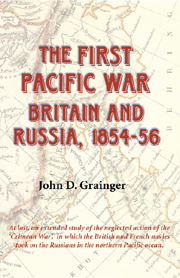Book contents
Summary
The conclusion of a peace treaty was notified to all commanders-in-chief of British naval stations by a circular letter from the Admiralty dated 4 April 1856. It had been well signposted in advance, and had been expected in Europe at any time from February onwards. This expectation had diffused outwards, and was received in the Pacific and China commands by April, though the official news did not arrive until early in June and did not reach the Allied naval forces until the beginning of July. This uncertainty made it impossible to do more than make preparations in case no peace was made, which cannot have been very inspiring.
Admiral Stirling took his ships to winter in China, the British at Hong Kong, and the French at Shanghai. His concern returned to the problem of Chinese piracy, but he also felt he had been maligned by some criticism from a man called ‘Mr Phin’. He wrote to the Admiralty justifying his conduct in the search for the Russian ships, explaining why he sent Styx and Tartar back to Hakodate, and giving chapter and verse for his original belief that there was no strait separating Sakhalin from the Amur. (The Admiralty drafted a reply, which may or may not have been sent, but which maintained the old criticism of him: he had in fact attacked the naval bureaucracy, and that was a fight no one could win.)
- Type
- Chapter
- Information
- The First Pacific WarBritain and Russia, 1854–56, pp. 179 - 189Publisher: Boydell & BrewerPrint publication year: 2008



